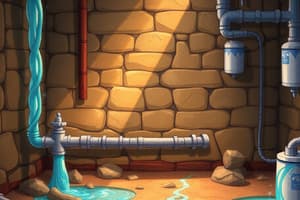Podcast
Questions and Answers
What is another name for the drainage, waste, and vent system?
What is another name for the drainage, waste, and vent system?
- Industrial wastewater system
- Irrigation and supply system
- Sanitary drainage and vent system (correct)
- Stormwater disposal system
Which of the following describes the function of a vent system in plumbing?
Which of the following describes the function of a vent system in plumbing?
- To filter solid waste from effluent
- To manage the flow of potable water
- To maintain atmospheric pressure in drain lines and exhaust sewer gases (correct)
- To directly cool wastewater before discharge
What is the primary function of traps in a sanitary drainage system?
What is the primary function of traps in a sanitary drainage system?
- To accelerate the draining process
- To catch and hold a small quantity of wastewater (correct)
- To filter out large debris
- To aerate the wastewater flow
Which factor contributes most directly to trap seal loss due to backpressure?
Which factor contributes most directly to trap seal loss due to backpressure?
What mechanism explains trap seal loss occurring because of threads, hair, and other small fibers?
What mechanism explains trap seal loss occurring because of threads, hair, and other small fibers?
Which scenario best describes trap seal loss due to evaporation?
Which scenario best describes trap seal loss due to evaporation?
What causes trap seal loss due to direct or self-siphonage?
What causes trap seal loss due to direct or self-siphonage?
How does indirect or momentum siphonage lead to trap seal loss?
How does indirect or momentum siphonage lead to trap seal loss?
What is the primary cause of trap seal loss due to the wavering or wind effect?
What is the primary cause of trap seal loss due to the wavering or wind effect?
What is another name for interceptors within a plumbing system?
What is another name for interceptors within a plumbing system?
In what type of establishment would you most likely find a grease trap or interceptor?
In what type of establishment would you most likely find a grease trap or interceptor?
In which setting is an oil-sand interceptor most essential?
In which setting is an oil-sand interceptor most essential?
What is the purpose of an oil-sand interceptor in a wastewater system?
What is the purpose of an oil-sand interceptor in a wastewater system?
What is the function of a fixture drain?
What is the function of a fixture drain?
How does a fixture branch relate to fixture drains?
How does a fixture branch relate to fixture drains?
What type of pipe is a 'stack' within a plumbing system?
What type of pipe is a 'stack' within a plumbing system?
What differentiates a soil stack from a waste stack?
What differentiates a soil stack from a waste stack?
What is the function of a building drain?
What is the function of a building drain?
What is the role of the building sewer in relation to the building drain?
What is the role of the building sewer in relation to the building drain?
Where does the sanitary sewer main typically transport wastewater?
Where does the sanitary sewer main typically transport wastewater?
What is the purpose of cleanouts in a plumbing system?
What is the purpose of cleanouts in a plumbing system?
What is the main purpose of a vent pipe in a plumbing system?
What is the main purpose of a vent pipe in a plumbing system?
A vertical vent pipe installed to provide air circulation to and from any part of the drainage system is best described as which of the following?
A vertical vent pipe installed to provide air circulation to and from any part of the drainage system is best described as which of the following?
What describes a stack vent?
What describes a stack vent?
What is another term for an individual vent?
What is another term for an individual vent?
What characterizes a continous vent?
What characterizes a continous vent?
What scenario uses a common vent?
What scenario uses a common vent?
To what does the group vent pipe connect in a ciruit vent configuration?
To what does the group vent pipe connect in a ciruit vent configuration?
Loop vents connect to which component?
Loop vents connect to which component?
What is the defining characteristic of a wet vent?
What is the defining characteristic of a wet vent?
What is transported by a dry vent?
What is transported by a dry vent?
What does a local vent convey?
What does a local vent convey?
In addition to its other functions, what else can a relief vent serve as?
In addition to its other functions, what else can a relief vent serve as?
What is the connecting point for a yoke vent?
What is the connecting point for a yoke vent?
Which issue is a yoke vent designed to mitigate?
Which issue is a yoke vent designed to mitigate?
Among the choices, which best describes the drainage, waste and vent systems overall function?
Among the choices, which best describes the drainage, waste and vent systems overall function?
Flashcards
Sanitary Drainage and Vent System
Sanitary Drainage and Vent System
A network of pipes that remove wastewater from a building.
Sanitary Drainage
Sanitary Drainage
Traps at each fixture, fixture branch, stack and drain pipes that carry wastewater away from the plumbing fixtures.
Vent System
Vent System
Introduces and circulates air in the system to maintain atmospheric pressure.
Traps
Traps
Signup and view all the flashcards
Trap Seal Loss
Trap Seal Loss
Signup and view all the flashcards
Backpressure
Backpressure
Signup and view all the flashcards
Capillary Action
Capillary Action
Signup and view all the flashcards
Evaporation
Evaporation
Signup and view all the flashcards
Direct or Self-Siphonage
Direct or Self-Siphonage
Signup and view all the flashcards
Indirect or Momentum Siphonage
Indirect or Momentum Siphonage
Signup and view all the flashcards
Wavering or Wind Effect
Wavering or Wind Effect
Signup and view all the flashcards
Interceptors
Interceptors
Signup and view all the flashcards
Interceptors
Interceptors
Signup and view all the flashcards
Grease Trap or Interceptor
Grease Trap or Interceptor
Signup and view all the flashcards
Oil-Sand Interceptor
Oil-Sand Interceptor
Signup and view all the flashcards
Fixture Drain
Fixture Drain
Signup and view all the flashcards
Fixture Branch
Fixture Branch
Signup and view all the flashcards
Stack
Stack
Signup and view all the flashcards
Soil Stack
Soil Stack
Signup and view all the flashcards
Waste Stack
Waste Stack
Signup and view all the flashcards
Building Drain
Building Drain
Signup and view all the flashcards
Building Sewer
Building Sewer
Signup and view all the flashcards
Sanitary Sewer Main
Sanitary Sewer Main
Signup and view all the flashcards
Cleanouts
Cleanouts
Signup and view all the flashcards
Vent Pipe
Vent Pipe
Signup and view all the flashcards
Vent Stack
Vent Stack
Signup and view all the flashcards
Stack Vent
Stack Vent
Signup and view all the flashcards
Stack Vent Through Roof
Stack Vent Through Roof
Signup and view all the flashcards
Individual Vent
Individual Vent
Signup and view all the flashcards
Individual Vent
Individual Vent
Signup and view all the flashcards
Continuous Vent
Continuous Vent
Signup and view all the flashcards
Common Vent
Common Vent
Signup and view all the flashcards
Circuit Vent
Circuit Vent
Signup and view all the flashcards
Loop Vent
Loop Vent
Signup and view all the flashcards
Wet Vent
Wet Vent
Signup and view all the flashcards
Dry Vent
Dry Vent
Signup and view all the flashcards
Local Vent
Local Vent
Signup and view all the flashcards
Relief Vent
Relief Vent
Signup and view all the flashcards
Yoke Vent
Yoke Vent
Signup and view all the flashcards
Study Notes
Drainage, Waste, and Vent System
- This system sometimes is called the Sanitary Drainage and Vent System
- It involves a network of pipes removing wastewater from buildings
Sanitary Drainage
- Sanitary Drainage features traps at each fixture
- Fixture branches, stacks, and drain pipes transport wastewater to plumbing fixtures of a building
Vent System
- The vent system introduces and circulates air
- This helps maintain atmospheric pressure in the drain lines
- Adequate gravity flow for wastewater relies on maintaining atmospheric pressure
- Venting exhausts sewer gases outdoors
- Venting prevents systems from having negative pressure
- Preventing negative pressure stops sucking water from fixture traps
Traps
- Traps involve U-shaped pipes
- These pipes capture and hold a small amount of wastewater as it is poured down a fixture drain
Trap Seal Loss
- Loss of water seal in a trap will let objectionable sewer gases to go into the building
- Trap Seal Loss can occur due to:
- Backpressure
- Capillary action
- Evaporation
- Direct or self-siphonage
- Indirect or momentum siphonage
- Wavering or wind effect
Backpressure
- Backpressure is caused by positive pressure
- This happens when a large amount of water discharges into a stack from upper floors, creating pressure at the base
- Without adequate ventilation, this pressure may remove a trap seal
Capillary Action
- Capillary action is the wicking away of a water seal
- Foreign objects like hair, thread, cloth, or fibers lodged into the trap and extending towards the outlet can cause this
Evaporation
- Evaporation occurs in traps connected to infrequently used fixtures at high temperatures
- The water in the seal evaporates
Direct or Self-Siphonage
- Direct or Self-Siphonage are caused by negative pressure
- Occurs in unventilated traps serving oval-bottom fixtures, like lavatories or slop sinks
- Created by a rapid flow of water through the pipe
Indirect or Momentum Siphonage
- Indirect or Momentum Siphonage is caused by negative pressure
- Happens when water discharged from one fixture pulls the trap seal of another fixture on the same discharge line
Wavering or Wind Effect
- Wavering or Wind Effect is caused by high-velocity fluctuating wind across the top of the stack vent
- This creates a wave motion in the trap, causing water to wash over the weir
Interceptors
- Interceptors are passive devices in plumbing systems
- They trap, separate, and retain toxic or undesirable wastewater substances before discharge to sewer lines
- Interceptors are also called Clarifiers
Grease Trap or Interceptor
- Grease traps receive wastewater from sinks, dishwashers, and floor drains
- They can be found in restaurants, cafeterias, and commercial food establishments before being drained to the sewer system
Oil-Sand Interceptor
- These separate and remove floatable (oils) and settleable (sand/metals) materials from wastewater before sewer discharge
- This type of interceptor is used in manufacturing plants, vehicle service facilities, and car washes
Fixture Drain
- The drainpipe runs from the trap of a fixture to the junction with another drainpipe
Fixture Branch
- This drainpipe connects two or more fixture drains to a main drain or stack
Stack
- The general term for any vertical line of soil, waste, or vent piping
- A vertical pipe that fixture branches feed into
Soil Stack
- Soil Stacks carry wastewater from water closets or similar fixtures
- Includes human wastes
Waste Stack
- These carry all wastes except human wastes
Building Drain
- A building drain is part of the lowest horizontal piping of a drainage system
- Receives discharge from soil, waste, and drainage pipes within the building walls
- It conveys it to the building sewer starting 0.60 m outside the building wall
Building Sewer
- A building sewer is horizontal piping for drainage
- It receives discharge that begins from the end of the building drain
- Conveys the discharge to a public, private, or individual sewage disposal system or disposal point
Sanitary Sewer Main
- The sanitary sewer main is the pipe which wastewater flows through
- It conveys wastewater from a building to a wastewater treatment plant
Cleanouts
- This is a plug or cover joined to an opening in a pipe
- This part removed to allow access for pipe inspection or cleaning
Vent Pipe
- This pipe ensures circulation of air in the plumbing system while relieving negative pressure on trap seals
Vent stack
- A vent stack is a vertical vent pipe for air circulation to and from any drainage system part
Stack Vent
- A stack vent is the extension of a soil or waste stack above the highest horizontal drain connected to the stack
- Stack Vent Through Roof is the uppermost end of the stack vent above the roof
Individual Vent
- A individual vent installed to vent a fixture trap
- It connects to the vent system above the fixture or terminates in the open air
- Can be called Revent Pipe or Backvent Pipe
Continuous Vent
- This is a vertical vent that is a continuation of the drain it connects to
Common Vent
- A common vent is a single vent at the junction of two fixture drains
- It serves as a vent for two traps
Circuit Vent
- This vent group starts in front of the extreme fixture connection on a horizontal branch
- It connects to the vent stack
Loop Vent
- This vertical vent connects on a horizontal soil or waste pipe branch
- It's downstream of the last fixture connection, turning toward the highest overflow level of the highest fixture
- The end is then connected to the stack vent
Wet Vent
- Wet vents have a portion of the vent pipe where wastewater flows
Dry Vent
- Dry vents don't carry liquid or water-borne wastes
Local Vent
- This pipe or shaft conveys foul air from a plumbing fixture or room to the outer air
Relief Vent
- Relief vents are vertical vent lines that help circulate air better between the drainage and vent systems
- It can be an auxiliary vent on specially designed systems
Yoke Vent
- This connects upward from a soil or waste stack below the floor and horizontal connection to an adjacent vent stack
- This is above the floor and higher than the highest spill level of fixtures
- It works to prevent pressure changes in the stacks
Studying That Suits You
Use AI to generate personalized quizzes and flashcards to suit your learning preferences.




